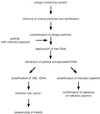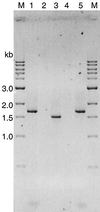Method for host-independent detection of generalized transducing bacteriophages in natural habitats
- PMID: 11282595
- PMCID: PMC92759
- DOI: 10.1128/AEM.67.4.1490-1493.2001
Method for host-independent detection of generalized transducing bacteriophages in natural habitats
Abstract
Despite an increasing interest in horizontal gene transfer in bacteria, the role of generalized transduction in this process has not been well investigated yet. Certainly one of the reasons is that only a small fraction of general transducing bacteriophages have been characterized, because many bacterial hosts needed for propagation and identification are not culturable or are simply unknown. A method for host-independent detection of transducing bacteriophages was developed. Phage-encapsulated DNA was used as a template for PCR amplification of 16S ribosomal DNA using primers specific for the 16S rRNA genes of most eubacteria. Sequencing of the cloned amplification products permits the identification of the host bacteria. The Salmonella phage P22 was used as an example. Applying this method to a sample of the supernatant of the mixed liquor in the aeration tank of an activated sludge treatment works revealed the presence of transducing phages infecting several bacterial species for which such phages have not yet been described. This method is suitable for estimating the contribution of generalized transduction to horizontal gene transfer in different habitats.
Figures


References
-
- Altschul S F, Gish W, Miller W, Myers E W, Lipman D J. Basic local alignment search tool. J Mol Biol. 1990;215:403–410. - PubMed
-
- Holmes D S, Quigley M. A rapid boiling method for preparation of bacterial plasmids. Anal Biochem. 1981;114:193. - PubMed
-
- Maniatis T, Fritsch E F, Sambrook J. Molecular cloning: a laboratory manual. Cold Spring Harbor, N.Y: Cold Spring Harbor Laboratory Press; 1982.
-
- Noller H F. Structure of ribosomal RNA. Annu Rev Biochem. 1983;53:119–162. - PubMed
Publication types
MeSH terms
Substances
Associated data
- Actions
- Actions
- Actions
- Actions
- Actions
- Actions
- Actions
- Actions
- Actions
- Actions
LinkOut - more resources
Full Text Sources
Molecular Biology Databases

